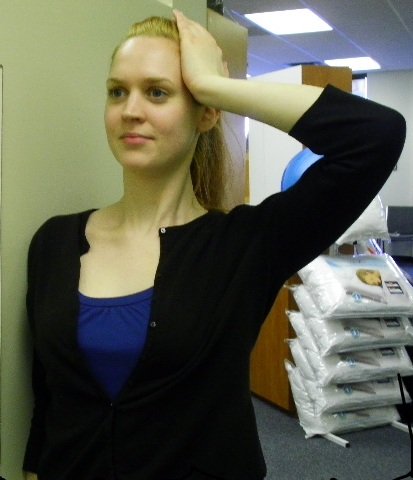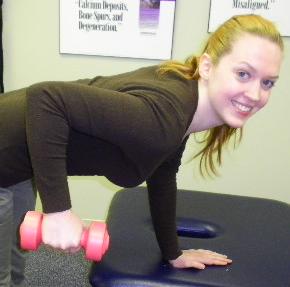
Scoliosis exercise can be a very effective part of a more comprehensive treatment plan for scoliosis. It’s the type of scoliosis exercise that is key! Exercise for scoliosis can be divided into two groups. Isometric and Isotonic.
Isometric scoliosis exercise is a way to exercise the muscles while in a stationary position. Isometric exercise is experienced by pushing or pulling a fixed object, like a bar anchored to the wall or floor, or even another body part that is stationary. Research has shown that a muscle contraction during isometric exercise produces more force than a contraction generated by lifting weights. Isometric scoliosis exercises can provide impressive results with minimal strain on the spine.

Isotonic scoliosis exercise can be performed with free weights or with fixed equipment. Isotonic literally means equal tension. Isotonic contraction is when the tension remains constant as the muscle shortens or lengthens with body movement.
Here is a video of some scoliosis isometric exercises and stretching exercise:
[youtube=//www.youtube.com/watch?v=-f1feg7px7o&feature=plcp&rel=0]
If you are unsure of the correct way to perform an exercise, please let your scoliosis specialist know immediately as any exercise not done correctly will not have a positive impact on your spine.
CLEAR Institute Method
The CLEAR approach achieves scoliosis reduction and stabilization by “unlocking” the curvature from the original position, mobilizing the spinal joints back to a normal range-of-motion, and then “re-locking” the new, straighter spinal curvature by retraining the brain to learn the new spinal position. The scoliosis exercise program is based on examination findings including:respiratory function testing, standard orthopedic testing, chiropractic evaluation, X-ray examination, digital posture examination, and proprioceptive and balance examinations.
It is important to note with any scoliosis exercises program–even isometric scoliosis exercises–exercise should be only one part of the whole treatment program of care. Exercise and scoliosis stretches alone will not achieve effective results. This is because scoliosis primarily results from a problem in the automatic postural control centers of the brain. Research has revealed that in scoliotic spines, the brain doesn’t “recognize” the scoliosis spine as out of alignment and therefore, simply doesn’t trigger the spinal auto-correction mechanisms that would fix the scoliosis. Exercises will increase flexibility and strength which may minimize pain and discomfort and improve posture visibly, but the curve size will remain the same.
Exercise treatments and stretches for scoliosis need to be performed in conjunction with a specific focus on creating a “stimulus” that triggers the brain to recognize that there is an abnormality and make the necessary auto-correction to the spinal posture. This stimulus must affect the body at a subconscious level in order to create any meaningful changes in posture. If posture changes are accomplished willfully and consciously, as soon as the patient takes their attention off their posture, they will revert back to the baseline posture which is supporting the scoliosis. In other words, any type of voluntary movement exercises for scoliosis simply are overriding the subconscious automatic postural control centers in the brain and not allowing them to truly “learn” how to auto-correct the scoliosis spine.
The most effective scoliosis stretches and exercises must be performed along with patient specific 3 dimensional body corrective exercises called neuromuscular re-education. This method uses the automatic postural control centers in the brain which are stimulated subconsciously. A patient specific pattern of three dimensional weighting (neuromuscular re-education) that manipulates the spine and posture, is a necessary stimulus and when used in conjunction with the specifically prescribed scoliosis exercises, can provide dramatic results by causing subconscious muscle response, both lengthening and strengthening muscles and retraining the entire posture to assume a more balanced alignment to gravity. This results in first a stabilization and then a reduction of the magnitude of the scoliotic spine. All these exercises are prescribed individually and based upon the initial physical and xray examinations.
Our center employs the CLEAR Institutes method of treatment which includes a scoliosis exercise program that focuses on isometric scoliosis exercises and scoliosis stretching exercises. This approach is not painful, exhausting or physically demanding. Unlike other exercises for scoliosis, such as Schroth, this program does not require tremendous effort nor precise movements or positions from the patient. Since scoliosis cannot be created through conscious movement or positioning, scoliosis cannot be permanently corrected through conscious movement. Since the body responds in time and in need to its environment by challenging the postural reflexes correctly, we can cause the body to adapt to this increased demand and significantly reduce an existing spinal curvature and in some instances eliminate the scoliosis all together. This program employs muscle memory through challenging the body’s postural righting reflexes which control spinal alignment.
While the scoliosis patient can still participate in other forms of exercise, such as swimming, running, Pilates, or yoga, it is important that these other forms of exercise not be used as scoliosis treatment alone and that care is insured that they do not inhibit treatment or exacerbate the existing curvature. That is why, with all forms of exercise for scoliosis and stretches for scoliosis, it is important to discuss exercise options with a scoliosis specialist. The scoliosis exercises must be individually designed for the scoliosis patient as each patient has a unique distortion of the spine, balance ability, levels of restricted movement, as well as other factors that must be taken into consideration. Because of changes or limitations that can present with different ages groups, there are exercises for scoliosis in children and scoliosis exercises for adults. Scoliosis is different in every patient and the best scoliosis exercises vary from patient to patient.